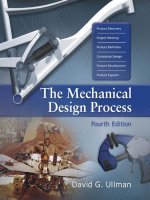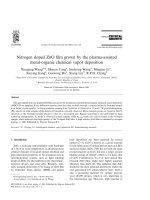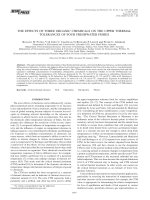Peter jones the mould design Guide(BookZZ org)
Bạn đang xem bản rút gọn của tài liệu. Xem và tải ngay bản đầy đủ của tài liệu tại đây (16.82 MB, 512 trang )
The Mould Design Guide
Peter Jones
The Mould Design Guide
Peter Jones
Smithers Rapra Technology Limited
A wholly owned subsidiary of The Smithers Group
Shawbury, Shrewsbury, Shropshire, SY4 4NR, United Kingdom
Telephone: +44 (0)1939 250383 Fax: +44 (0)1939 251118
First Published in 2008 by
Smithers Rapra Technology Limited
Shawbury, Shrewsbury, Shropshire, SY4 4NR, UK
©2008, Smithers Rapra Technology Limited
All rights reserved. Except as permitted under current legislation no part
of this publication may be photocopied, reproduced or distributed in any
form or by any means or stored in a database or retrieval system, without
the prior permission from the copyright holder.
A catalogue record for this book is available from the British Library.
Every effort has been made to contact copyright holders of any material reproduced
within the text and the authors and publishers apologise if any have been overlooked.
Soft-backed ISBN: 978-1-84735-088-6
Hard-backed ISBN: 978-1-84735-087-9
Typeset by documen.co.uk
Cover designed by Smithers Rapra Technology Limited
Printed and bound by Lightning Source
Contents
1
Introduction ......................................................................................................... 1
2
The Injection Moulding Process ............................................................................ 5
2.1
Background .............................................................................................. 5
2.2
Machine Design ........................................................................................ 6
2.2.1
Machine Base Unit ...................................................................... 6
2.2.2
Clamp Unit ................................................................................. 6
2.2.3
Mould Height ............................................................................. 6
2.2.4
Daylight...................................................................................... 7
2.2.5
Distance Between Tie Bars........................................................... 8
2.2.6
Clamping Mechanisms ................................................................ 9
2.2.7
The Injection Unit ..................................................................... 13
2.3
Theoretical Mould Locking Force............................................................ 19
2.4
The Moulding Cycle ............................................................................... 20
2.4.1
Mould Closing Phase................................................................. 20
2.4.2
Mould Protection Phase ............................................................ 20
2.4.3
Injection (Mould Filling) Phase .................................................. 20
2.4.4
Holding Time and Pressurising Phase......................................... 20
2.4.5
Cooling and Refill Phase............................................................ 21
2.4.6
Screw Back Phase ...................................................................... 21
2.4.7
Mould Open Phase.................................................................... 21
2.4.8
Ejection Phase ........................................................................... 22
i
Mould Design Guide
3
ii
Plastics Materials................................................................................................ 23
3.1
Types of Plastics Materials ...................................................................... 23
3.2
Definition of Plastics ............................................................................... 23
3.3
The Nature of Plastics Materials ............................................................. 24
3.4
Monomers, Polymerisation and Polymers ................................................ 25
3.5
Classification of Plastics.......................................................................... 26
3.5.1
Thermosets and Thermoplastics ................................................ 26
3.5.2
Homopolymers, Copolymers and Polymer Blends (Alloys) ......... 27
3.5.3
Amorphous and Semicrystalline Thermoplastics ........................ 29
3.6
Melting and Solidification ....................................................................... 30
3.7
Shrinkage ............................................................................................... 31
3.8
Engineering and Commodity Plastics ....................................................... 32
3.8.1
Engineering Plastics................................................................... 32
3.8.2
Commodity Plastics .................................................................. 32
3.9
Material Additives .................................................................................. 33
3.10
Flow Properties of Thermoplastic Materials............................................. 35
3.11
Variable Molecular Weight ..................................................................... 35
3.12
Melt Flow Index (MFI) ........................................................................... 36
3.13
Reprocessed Material.............................................................................. 37
3.14
Polymer Molecules.................................................................................. 37
3.15
Material Names and Abbreviations ......................................................... 37
3.16
Material Applications ............................................................................. 40
Contents
3.17
4
The Behaviour of Thermoplastics
During the Injection Moulding Process .................................................... 41
3.17.1
Pretreatment of Materials Before Injection Moulding ................. 41
3.17.2
Reprocessed Materials............................................................... 41
3.17.3
Colouring Materials .................................................................. 41
3.17.4
Additives .................................................................................. 41
3.17.5
Material Drying ........................................................................ 42
3.17.6
Plasticising or Melting ............................................................... 43
3.17.7
Measurement of Melt Temperature ........................................... 44
3.17.8
Degradation of Materials During Plasticising ............................. 44
3.17.9
Selecting the Optimum Melt Temperature.................................. 45
3.17.10
The Effect of Screw Rotational Speed and Back Pressure ............ 45
3.17.11
Flow Characteristics of the Melt During the Injection Phase ....... 46
3.17.12
Selection of Injection Speed ....................................................... 46
3.18
Initial Cavity Filling Phase....................................................................... 48
3.19
Cavity Holding Pressure Phase ................................................................ 49
3.20
Gate Freeze-off Phase .............................................................................. 49
3.21
Melt Compressibility and Shrinkage ........................................................ 49
3.22
Sinks and Voids ...................................................................................... 50
3.23
Weld Lines and Meld Lines ..................................................................... 53
3.24
Cooling and Solidification of the Melt ..................................................... 54
Good Design Practice.......................................................................................... 55
4.1
Predesign Analysis .................................................................................. 56
4.2
Reading General Arrangement Diagrams (GA) ........................................ 56
4.3
Understanding Toolmaking Concepts...................................................... 57
iii
Mould Design Guide
5
6
iv
4.4
Observing Mould Tools .......................................................................... 58
4.5
Summary of Good Design Practice........................................................... 58
Design Checklist ................................................................................................. 59
5.1
Predesign Checklist ................................................................................. 59
5.2
Original Estimate Details ........................................................................ 60
5.3
Component Drawing .............................................................................. 60
5.4
Component Geometry............................................................................. 60
5.5
Component Material............................................................................... 61
5.6
Quantity Required .................................................................................. 61
5.7
Component Function .............................................................................. 61
5.8
Component Tolerances ........................................................................... 62
5.9
Number of Impressions ........................................................................... 62
5.10
Gating Method ....................................................................................... 62
5.11
Ejection Method ..................................................................................... 63
5.12
Component Aesthetics ............................................................................ 63
Determining the Right Number of Impressions .................................................... 65
6.1
Quality Versus Quantity ......................................................................... 66
6.2
Appearance............................................................................................. 66
6.3
Part Geometry ........................................................................................ 67
6.4
Drawing Tolerances................................................................................ 67
6.5
Discussion .............................................................................................. 67
6.6
More Cavities = Less Control.................................................................. 68
6.7
Summary ................................................................................................ 70
Mould Design Guide
9
Milling ..................................................................................... 86
8.3.4
Grinding ................................................................................... 87
8.3.5
Fabrication ............................................................................... 88
8.3.6
Standard Electrodischarge Machining (EDM) ............................ 89
8.3.7
Wire Electrodischarge Machining .............................................. 91
8.3.8
Cold Hobbing ........................................................................... 92
8.3.9
Beryllium-Copper...................................................................... 93
8.3.10
Electroforming.......................................................................... 93
8.3.11
Cavity Corrosion and Erosion ................................................... 95
8.3.12
Gassing and Burning ................................................................. 95
8.4
Differential Shrinkage ............................................................................. 96
8.5
Maximum Metal Conditions ................................................................... 97
8.6
Example ................................................................................................. 97
Two-Plate Mould Tools...................................................................................... 99
9.1
vi
8.3.3
Design Details......................................................................................... 99
9.1.1
Locating or Register Ring .........................................................101
9.1.2
Top Plate.................................................................................101
9.1.3
Split Line .................................................................................102
9.1.4
Cavity Insert ............................................................................102
9.1.5
Front Cavity Plate ....................................................................102
9.1.6
Rear Cavity Plate .....................................................................102
9.1.7
Cavity Support Plate ................................................................103
9.1.8
Ejection System ........................................................................103
9.1.9
Ejection Gap ............................................................................104
Contents
10
9.1.10
Support Blocks.........................................................................104
9.1.11
Guide Pillar..............................................................................104
9.1.12
Return Pins ..............................................................................104
9.1.13
Fine Tuning the Mould Tool ....................................................104
9.1.14
Clearances ...............................................................................106
9.1.15
Bushes .....................................................................................106
9.1.16
Screws .....................................................................................106
9.1.17
Support Pillars .........................................................................106
9.1.18
Taper Threads .........................................................................107
9.1.19
Stand-off Buttons .....................................................................107
9.1.20
Chamfers and Radii .................................................................107
9.1.21
Guide Bushes ...........................................................................107
Ejection Systems ................................................................................................109
10.1
Requirements.........................................................................................109
10.1.1
Part Geometry..........................................................................109
10.1.2
Draft Angles ............................................................................109
10.1.3
Tolerances ...............................................................................110
10.1.4
Material...................................................................................110
10.1.5
Gating .....................................................................................111
10.1.6
Ejection Balance.......................................................................112
10.1.7
Machine Specifications.............................................................113
10.1.8
Mould Opening Stroke.............................................................113
10.1.9
Machine Ejection Features........................................................113
10.1.10
Movement Control Features .....................................................114
10.1.11
Component Finish Requirements ..............................................114
vii
Mould Design Guide
10.2
Ejection Methods...................................................................................114
10.2.1
Ejector Pins and Blades.............................................................114
10.2.2
Sleeve Ejectors..........................................................................116
10.2.3
Stripper Plate Ejection ..............................................................117
10.2.4
Valve Ejection..........................................................................118
10.2.5
Ejection Forces.........................................................................119
10.3
Ejection Force Calculation .....................................................................120
10.4
Formulae ...............................................................................................120
10.4.1
10.5
10.6
11
Ejection Assembly Actuation ..................................................................122
10.5.1
Mechanical Ejection .................................................................122
10.5.2
Hydraulic Ejection ...................................................................125
10.5.3
Pneumatic Ejection...................................................................126
10.5.4
Hybrid Ejection Systems...........................................................126
10.5.5
Double Ejection .......................................................................129
Unsatisfactory Systems...........................................................................132
Mould Temperature Control..............................................................................133
11.1
Discussion .............................................................................................133
11.2
Heat Transfer Fluids ..............................................................................134
11.2.1
Water ......................................................................................134
11.2.2
Heat Transfer Oil ....................................................................134
11.3
Chillers..................................................................................................135
11.4
Temperature Controllers........................................................................135
11.5
Cooling Channels ..................................................................................135
11.5.1
viii
Example ..................................................................................121
Core Cooling ...........................................................................137
Contents
11.6
Cavity Cooling.......................................................................................145
11.7
Circuit Efficiency ...................................................................................148
11.7.1
Series Cooling ..........................................................................148
11.7.2
Parallel Cooling .......................................................................149
11.8
Beryllium-Copper Cores and Cavities .....................................................150
11.9
Factors Affecting the Cooling Cycle........................................................150
11.9.1
Part Geometry..........................................................................151
11.9.2
Wall Sections ...........................................................................151
11.9.3
Moulding Material...................................................................151
11.9.4
Influence of the Gate and Runner..............................................152
11.9.5
The Mould Material.................................................................152
11.10
Mould Temperature Control..................................................................152
11.11
Cooling Efficiency..................................................................................153
11.11.1
Cavity Material and Construction.............................................153
11.11.2
Channel Geometry ...................................................................154
11.11.3
Number of Channels Required .................................................154
11.11.4
Rate of Coolant Flow ...............................................................154
11.12
Coolants................................................................................................155
11.12.1
11.13
Cooling Calculations..............................................................................155
11.13.1
11.14
Thermal Conductance of Metals...............................................155
Specific Heat............................................................................155
Pulsed Mould Cooling............................................................................161
11.14.1
Selective Pulsed Cooling ...........................................................162
11.15
Mould Cooling Variables .......................................................................163
11.16
Summary ...............................................................................................163
ix
Mould Design Guide
12
Undercut Injection Mould Tools ........................................................................165
12.1
12.2
Introduction ..........................................................................................165
12.1.1
Undercut Components .............................................................167
12.1.2
Basic Undercut Mould Designs .................................................168
12.1.3
Loose Inserts............................................................................168
12.1.4
Moulding in Splits....................................................................170
12.1.5
Straight Angle Dowels..............................................................170
Key Design Features...............................................................................172
12.2.1
12.3
12.4
Offset Angle Dowels ..............................................................................175
12.3.1
Key Design Features .................................................................177
12.3.2
To Establish Point P .................................................................177
Use of Side Cores ...................................................................................178
12.4.1
12.5
12.6
x
Example ..................................................................................173
Discussion ...............................................................................178
Angled Lift Splits ...................................................................................179
12.5.1
Discussion ...............................................................................179
12.5.2
Description of Operation..........................................................181
12.5.3
Key Design Features .................................................................181
12.5.4
Formulae .................................................................................181
Form Pins ..............................................................................................182
12.6.1
Discussion ...............................................................................182
12.6.2
Straight Action Form Pins.........................................................182
12.6.3
Key Design Features .................................................................183
12.6.4
Angled Form Pins.....................................................................184
12.6.5
Angled Action Form Pin ...........................................................185
Contents
12.6.6
Description of Operation..........................................................186
12.6.7
Key Design Features .................................................................186
12.6.8
Description of Operation..........................................................188
12.6.9
Key Design Features .................................................................188
12.7
Nonstandard Side Core Designs .............................................................188
12.7.1
Undercuts at Angle to Tool Axis...............................................189
12.7.2
Description of Operation..........................................................189
12.7.3
Key Design Features .................................................................190
12.8
Curved Undercuts ..................................................................................190
12.8.1
Description of Operation..........................................................190
12.8.2
Key Design Features .................................................................192
12.9
Radial Undercuts ...................................................................................192
12.9.1
Description of Operation..........................................................195
12.9.2
Key Design Features .................................................................195
12.10
Undercuts on Helical Gears and Pump Impellers .....................................196
12.11
Normal Ejection Techniques ..................................................................196
12.11.1
Form of Undercut.....................................................................197
12.11.2
Component Material................................................................198
12.11.3
Satisfactory Materials...............................................................198
12.11.4
Unsatisfactory Materials...........................................................198
12.12
Special Ejection Designs .........................................................................199
12.12.1
Splitting the Component...........................................................200
12.12.2
Moulding in One Piece .............................................................202
12.12.3
Helical Ejection........................................................................202
xi
Mould Design Guide
13
Automatic Unscrewing Mould Tool Design ........................................................205
13.1
Introduction ..........................................................................................205
13.2
Injection Moulding Thread Forms ..........................................................206
13.3
Thread Geometry ..................................................................................207
13.4
13.5
13.3.1
Parallel Threads .......................................................................207
13.3.2
Number of Starts......................................................................207
13.3.3
Thread Form ...........................................................................208
13.3.4
Taper Threads .........................................................................213
13.3.5
British Standard Pipe Thread ....................................................214
13.3.6
Jointing Threads ......................................................................214
13.3.7
Longscrew Threads ..................................................................214
13.3.8
Moulded Thread Forms ...........................................................216
Thread Shrinkage Compensation............................................................217
13.4.1
Discussion ...............................................................................217
13.4.2
The Effect of Incorrect Shrinkage on Thread Forms ..................217
13.4.3
Pitch Inaccuracy.......................................................................218
13.4.4
Thread Form Inaccuracy ..........................................................218
13.4.5
Inaccurate Thread Diameters....................................................218
Application of Shrinkage Allowance on Thread Forms............................218
13.5.1
13.6
xii
Shrinkage Formulae .................................................................219
Injection Moulding Considerations.........................................................220
13.6.1
Moulding-related Problems ......................................................220
13.6.2
Injection Pressure .....................................................................220
13.6.3
Injection Speed.........................................................................220
13.6.4
Unscrewing Speed ....................................................................220
Contents
13.6.5
Ejection Speed..........................................................................220
13.6.6
Operating Window ..................................................................221
13.6.7
Tool Temperature Control .......................................................221
13.7
Basic Screw Thread Mould Designs ........................................................222
13.7.1
Split Tooling............................................................................222
13.7.2
Thread Jumping.......................................................................223
13.7.3
Collapsible Coring ...................................................................224
13.7.4
Operation of Multisegment Cores.............................................227
13.8
Rotary Unscrewing ................................................................................227
13.8.1
13.9
Collapsible Coring Details........................................................228
Types of Collapsible Core ......................................................................228
13.9.1
Two-segment Core Details .......................................................229
13.9.2
Multisegment Collapsible Cores ...............................................230
13.10
Using Silicone Rubber Sleeve Cores ........................................................231
13.10.1
Advantages ..............................................................................231
13.10.2
Disadvantages..........................................................................232
13.11
Core Unscrewing ...................................................................................234
13.11.1
Fixed Core Systems ..................................................................234
13.11.2
Cavity in Moving Half .............................................................234
13.11.3
Cavity in Fixed Half .................................................................235
13.11.4
Key Design Features of Figure 13.18..........................................238
13.12
Anti-Rotation Keying.............................................................................239
13.12.1
13.13
Base Key Geometry ..................................................................239
Moving Core Systems.............................................................................240
13.13.1
Key Design Features .................................................................241
xiii
Mould Design Guide
13.14
13.14.1
Key Design Features .................................................................244
13.14.2
Guidelines................................................................................245
13.15
Two-thread Unscrewing Designs ............................................................245
13.15.1
Discussion ...............................................................................245
13.15.2
Key Design Features for Two External Threads.........................245
13.15.3
Operation ................................................................................247
13.15.4
Key Design Features .................................................................249
13.15.5
Operation ................................................................................250
13.16
Gearing Geometry .................................................................................250
13.16.1
Introduction.............................................................................250
13.16.2
Basic Spur Gear Definitions ......................................................252
13.16.3
Basic Spur Gear Formulae ........................................................253
13.16.4
Conversion Between ISO and Imperial Systems .........................253
13.16.5
Example Gear Calculations (ISO) .............................................253
13.16.6
Guidelines for Gear Selection (ISO)...........................................255
13.16.7
Guidelines for Gear Train Design (ISO) ....................................255
13.17
xiv
Cavity Rotation .....................................................................................242
General Mould Design Guide for Threads ..............................................256
13.17.1
Observation .............................................................................256
13.17.2
Stage 1 .....................................................................................256
13.17.3
Stage 2 .....................................................................................257
13.17.4
Stage 3 .....................................................................................258
13.17.5
Stage 4 .....................................................................................259
13.17.6
Stage 5 .....................................................................................259
Contents
13.18
14
Driving Systems .....................................................................................260
13.18.1
Rack-and-Pinion Systems .........................................................260
13.18.2
Opening Movement of Mould Tool ..........................................260
13.18.3
Actuation by Cylinder ..............................................................261
13.18.4
Pneumatic Motors....................................................................263
13.18.5
Hydraulic Motors ....................................................................263
13.18.6
Electric Motors ........................................................................265
13.18.7
Clutches and Rotation Control .................................................265
13.18.8
Using Clutches .........................................................................266
13.18.9
Using Stepper Motors...............................................................267
13.18.10
Using Torque Limiters..............................................................268
13.19
Special Designs ......................................................................................269
13.20
Commercial Unscrewing Systems............................................................270
Multiplate Tool Systems ....................................................................................271
14.1
Three-Plate Tools ..................................................................................271
14.1.1
14.2
Multiplate Undercut Tools .....................................................................279
14.2.1
14.3
15
Three-Plate Tool Operation .....................................................273
Sequential Opening ..................................................................281
Stack Moulds.........................................................................................285
Runnerless Moulding.........................................................................................291
15.1
Sprueless Moulding................................................................................291
15.1.1
Basic Antechamber Type ..........................................................291
15.1.2
Heated Hot Sprue Bushes .........................................................293
15.1.3
Summary .................................................................................297
xv
Mould Design Guide
15.2
15.3
15.4
15.5
15.6
xvi
Insulated Runner Systems.......................................................................298
15.2.1
Insulated..................................................................................298
15.2.2
Semi-insulated..........................................................................299
Full Hot Runner Systems........................................................................300
15.3.1
Advantages Over Cold Runner Moulds.....................................300
15.3.2
Nozzles and Gate Bushes ..........................................................305
15.3.3
Open Gate Nozzles ..................................................................305
15.3.4
Spring-Operated Needle Nozzle................................................307
15.3.5
Hydraulically Operated Needle Valve Nozzle............................308
15.3.6
Multipoint Gating....................................................................309
15.3.7
Summary .................................................................................311
Heating .................................................................................................311
15.4.1
Band Heaters ...........................................................................311
15.4.2
Coil Heaters.............................................................................312
15.4.3
Cartridge Heaters.....................................................................312
15.4.4
Tubular Heaters.......................................................................312
15.4.5
Integral Heating .......................................................................313
15.4.6
Heat Pipes................................................................................313
Temperature Control in Manifolds.........................................................313
15.5.1
Closed-Loop Control ...............................................................314
15.5.2
Open-Loop Control .................................................................314
15.5.3
Other Factors...........................................................................314
Gating ...................................................................................................315
15.6.1
Pin and Edge Gating.................................................................315
15.6.2
Valve Gating............................................................................316
15.6.3
Thermal Sealing .......................................................................316
Mould Design Guide
16.5
16.6
17
Mould Finishing ....................................................................................340
16.5.1
Polishing..................................................................................341
16.5.2
Chromium Plating....................................................................341
16.5.3
Photochemical Etching .............................................................341
16.5.4
EDM Finishes ..........................................................................342
16.5.5
Bead Blasting ...........................................................................342
16.5.6
Vapour Blasting .......................................................................342
Mould Maintenance...............................................................................343
Runner and Gate Design ....................................................................................345
17.1
17.2
The Feed System ....................................................................................345
17.1.1
The Sprue ................................................................................346
17.1.2
Cold Slug Well .........................................................................346
17.1.3
Runner Design .........................................................................347
17.1.4
Runner System Design Rules ....................................................350
Calculating the Runner Length ...............................................................352
17.2.1
17.3
xviii
Example ..................................................................................353
Gate Design ...........................................................................................355
17.3.1
Manually Trimmed Gates ........................................................360
17.3.2
Automatically Trimmed Gates..................................................360
17.3.3
Gating Design Rules.................................................................362
17.3.4
Computer Simulations of Gate Designs .....................................363
17.3.5
Number and Location of Gates.................................................363
17.3.6
Gate Sizing...............................................................................365
17.3.7
Example ..................................................................................366
Contents
17.4
18
Gate Land Length ....................................................................367
17.3.9
Gate Diameter..........................................................................367
Establishing the Correct Gate Size ..........................................................369
17.4.1
Computer Analysis...................................................................370
17.4.2
Empirical Analysis ...................................................................370
Standard Mould Parts ........................................................................................373
18.1
19
17.3.8
Standard Parts Available ........................................................................373
18.1.1
Mould Base Units.....................................................................374
18.1.2
Mould Plates............................................................................374
18.1.3
Location and Alignment Components .......................................374
18.1.4
Ejection Components ...............................................................374
18.1.5
Feed Systems............................................................................374
18.1.6
Cooling Components ...............................................................375
18.1.7
Unscrewing Components..........................................................375
18.1.8
Miscellaneous ..........................................................................375
18.2
Mould Tool Designing Using Standard Parts...........................................375
18.3
Toolmaking Using Standard Parts ..........................................................376
18.4
Summary ...............................................................................................378
Deflection and Stress in Mould Components.......................................................379
19.1
Discussion .............................................................................................379
19.1.1
Competition.............................................................................380
19.1.2
Energy Costs............................................................................380
19.1.3
Breakages ................................................................................380
19.1.4
Deflection ................................................................................381
xix
Mould Design Guide
19.2
Force and Stress .....................................................................................381
19.2.1
Definitions of Forces ................................................................381
19.2.1.2
Compressive Force ...................................................................383
19.3
Stress.....................................................................................................384
19.4
Strain ....................................................................................................384
19.5
Stress–Strain Graph ...............................................................................385
19.5.1
Young’s Modulus of Elasticity ..................................................385
19.5.2
Limit of Proportionality ...........................................................386
19.5.3
The Elastic Limit......................................................................386
19.5.4
Yield Stress ..............................................................................386
19.5.5
Tensile Strength .......................................................................386
19.6
Factor of Safety (FOS)............................................................................386
19.6.1
Brittle materials .......................................................................387
19.6.2
Ductile materials ......................................................................387
19.7
Poisson’s Ratio ......................................................................................388
19.7.1
19.8
Temperature Stresses .............................................................................390
19.8.1
19.9
Example ..................................................................................390
Beam Theory .........................................................................................390
19.9.1
19.10
xx
Example ..................................................................................389
Beam Models ...........................................................................392
Bending Moments..................................................................................393
19.10.1
Neutral Axis ............................................................................393
19.10.2
Second Moment of Area ...........................................................394
19.11
Bending Formula ...................................................................................396
19.12
Section Modulus ....................................................................................396
Contents
19.13
Deflection of Beams ...............................................................................397
19.14
Analysing Mould Tools..........................................................................397
19.14.1
Two-Plate Example..................................................................397
19.14.2
Split Tool Example ..................................................................400
19.14.3
Analysing Core Pins .................................................................403
19.15
20
Summary ...............................................................................................405
Fatigue ..............................................................................................................407
20.1
Observations .........................................................................................407
20.2
Facts on Fatigue .....................................................................................408
20.3
Calculating Shut-off Areas .....................................................................410
20.3.1
20.4
20.5
21
Example ..................................................................................412
Factors Affecting Fatigue Life .................................................................414
20.4.1
Stress Concentrations ...............................................................414
20.4.2
Stress Raisers ...........................................................................416
20.4.3
Machining Marks.....................................................................418
20.4.4
The Effect of Surface Finish ......................................................419
20.4.5
Hardness Factors .....................................................................420
Summary ...............................................................................................421
Limits and Fits...................................................................................................423
21.1
Interchangeability ..................................................................................423
21.2
Tolerance ..............................................................................................423
21.3
21.2.1
Unilateral.................................................................................424
21.2.2
Bilateral ...................................................................................424
Limits....................................................................................................424
xxi
Mould Design Guide
21.4
21.5
Fits ........................................................................................................425
21.4.1
Running Fit..............................................................................425
21.4.2
Push Fit ...................................................................................426
21.4.3
Drive Fit ..................................................................................426
21.4.4
Force Fit ..................................................................................426
British Standard Hole and Shaft Fits .......................................................426
21.5.1
Clearance Fit............................................................................427
21.5.2
Transition Fit...........................................................................427
21.5.3
Interference Fit.........................................................................427
21.6
British Standard Clearance Fits...............................................................427
21.7
British Standard Clearance Fits – Hole Basis ...........................................429
21.7.1
21.8
22
xxii
Example ..................................................................................430
Geometric Tolerancing ..........................................................................431
Impression Blanking ..........................................................................................437
22.1
Reasons for Impression Blanking ............................................................437
22.2
Example ................................................................................................438
22.2.1
Original Estimate .....................................................................438
22.2.2
Effect of Running on Six Impressions........................................439
22.2.3
Effect of Running on a 6-imp Basis with an 18-second Cycle ......440
22.2.4
Cycle Required to Achieve Original Profit Level ........................440
22.2.5
Cycle Required to Break Even...................................................441
22.3
Observations .........................................................................................442
22.4
Summary ...............................................................................................442
Contents
22.5
Methods of Blanking Impressions ...........................................................442
22.5.1
Glueing....................................................................................443
22.5.2
Gate Blocking ..........................................................................443
22.5.3
Cavity Rotation .......................................................................443
22.5.4
Blanking the Branch Runner .....................................................445
22.6
23
Summary ...............................................................................................445
Summary of Mould Calculations ........................................................................447
23.1
Production Rates ...................................................................................447
23.2
Cooling Channel Diameters....................................................................447
23.3
Runner Length Formulae........................................................................448
23.4
Gate Design ...........................................................................................449
23.5
Ejection Forces.......................................................................................449
23.6
Stress and Strain.....................................................................................450
23.7
Factors of Safety ....................................................................................450
23.7.1
For Brittle Materials.................................................................450
23.7.2
For Ductile Materials ...............................................................450
23.8
Poisson’s Ratio ......................................................................................450
23.9
Moments of Inertia ................................................................................451
23.9.1
Rectangular Bar .......................................................................451
23.9.2
Circular Bar .............................................................................451
23.10
Temperature Stresses .............................................................................452
23.11
Bending Formulae ..................................................................................452
23.11.1
Section Modulus ......................................................................453
23.12
Deflection of Beams ...............................................................................453
23.13
Blanking Impressions .............................................................................454
xxii
i









